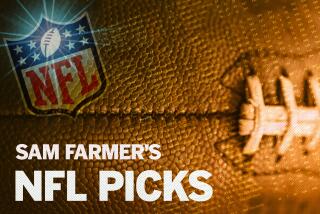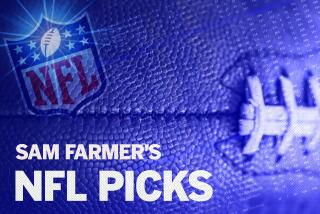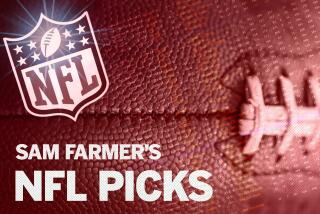Too bad Leinart is on wrong team
Matt Leinart has made only one important mistake in his football career. At USC, when drafted, Leinart agreed to play for the Arizona Cardinals. He would have been better off to sit out a year and re-enter the draft, playing for anyone else.
When still a Trojan, Leinart, some of us thought, was already the best quarterback in the country, with Carson Palmer second.
And as an NFL rookie playing only his second pro game Monday night, Leinart matched his great promise.
After his first nine passes that night, he had completed eight, and his team led, 14-0.
Normally, NFL rookies don’t throw two quick touchdown passes.
As rookies, most NFL quarterbacks don’t even play much.
Some good ones don’t get on the field.
But Leinart, with a veteran’s poise, dominated the game until the Cardinals, as usual, threw it away.
Or rather lost it because they quit throwing.
From the second quarter on, fearing turnovers, they tried to sit on a 17-point lead.
Thus the Chicago Bears, who don’t sit on leads, came from behind in the fourth quarter to win, 24-23.
Even so, Leinart emerged as one of the best rookie quarterbacks to start an NFL game -- possibly the best.
Bears are best bet
Sports fans seem to be reaching two conclusions about the quality of 2006 NFL football.
They’re agreeing, first, that there are more very good teams this year than usual.
But second, they’re saying there’s no real standout -- although the upstart Chicago entry, demonstrating the luck of champions as well as the skill, may be moving in that direction.
It has been so long since the Bears have been the league’s top dog that it could be a while before they prove they have the depth and staying power of a champion.
They do seem to be showing the required balance of offensive and defensive strength together with a tenacious confidence that comes from their coach, Lovie Smith.
They’re the season’s best bet.
Eight good ones
In all, this year’s 32-team NFL has at least eight very good ones. Among them are five from the NFC -- Chicago, New Orleans, Philadelphia, Seattle and St. Louis -- strengthening the possibility that the NFC has at last caught and passed the other conference.
The unifying characteristic of the NFC’s top five is that all are good passing teams.
And so are the AFC’s best: New England, Indianapolis and Cincinnati (along with, at times, Pittsburgh, Denver and San Diego.)
Through the years, the league, as of late October, hasn’t usually housed as many as eight strong Super Bowl candidates -- largely because this is the first time the league has ever combined eight good passing clubs.
Rarely in other Octobers have more than one or two teams stood out -- running or passing teams.
It’s an exciting time to be a football fan.
Aggressive passing
The Saints and Bears are the NFL’s surprise top dogs. Few reasonable people expected either of them to be contenders this season, but they and the Rams are now, clearly, comers.
It is their aggressive long-pass offenses that have put all three in a class with Philadelphia and Seattle as the NFL’s most competitive and most exciting teams -- those that participate regularly in closely played games.
With running back Reggie Bush and Coach Sean Payton, the Saints have been particularly impressive.
Who’s Payton?
At his last stop, Dallas, Coach Bill Parcells listed Payton as assistant head coach, an honor that Parcells hasn’t routinely awarded to his other offensive coordinators over the years.
To beat the Philadelphia Eagles last week, 27-24, New Orleans ended a 24-24 standoff with the winning plays: 16 runs and passes that moved the Saints 72 yards in their last, decisive drive. That drive consumed no fewer than the last eight minutes -- more than half the fourth quarter -- not an easy thing to do with a new team and new coach.
Payton would make it even easier on himself and his new team if he’d have quarterback Drew Brees throwing more often to Bush when the versatile former Trojan lines up at wide receiver.
At present, the Saints aren’t getting enough out of Bush, who would be a more valuable yardage producer if he were more often deployed here and there in the backfield and also on the line -- like Brian Westbrook of Philadelphia.
On throwing long
The Eagles are the league’s most effective downfield passing team now that they’re working in a bunch of long-range threats -- wide receivers Reggie Brown and Hank Baskett along with, among others, tight end L.J. Smith.
And they still feature runner-receiver Westbrook keeping the defense in line around the line of scrimmage.
Other examples of teams embracing this year’s long-pass trend are St. Louis, Indianapolis, Cincinnati (whenever the Bengals are comparatively free of injuries) and now the Bears.
The widely used West Coast short-pass offense, as introduced a few years ago by the man who brought passing back, former San Francisco coach Bill Walsh, is under siege.
There’s nothing wrong with the West Coast except that modern pro clubs have just about mastered the complicated defenses that take away short and middle-range passes.
These defenses -- particularly those aligned in the popular Tampa Bay two-deep -- are daring their opponents to throw long.
Accepting the dare, the Eagles have become the game’s most persistent long-pass team, at times throwing and sometimes completing two or three long passes on a given Sunday -- before halftime.
No trend lasts forever, but at present, pleasing thrill-seeking fans, NFL defenses haven’t found a sure way to handle long-pass offenses.
More to Read
Go beyond the scoreboard
Get the latest on L.A.'s teams in the daily Sports Report newsletter.
You may occasionally receive promotional content from the Los Angeles Times.










